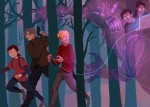BY EVAN CHARFAUROS
Games have always been a huge part of the entertainment industry, but what makes them entertaining? Game makers expend significant effort making design decisions people often don’t think about when they’re playing each game. Each week, columnist Evan Charfauros will examine the pros and cons of different game mechanics as seen in the modern gaming industry.
Players sign a deal with the developers when they boot up a horror game – for a thrilling experience, they forfeit free will.
Game developers continue to introduce countless features that enhance player autonomy, from character customization to fully explorable open-worlds. Modern video game design suggests the more control of the gameplay the player has, the better. But for the survival-horror genre, that philosophy flies out the shattered, dilapidated window.
Sure, horror games are filled to the brim with jump scares, gore and other shallow horror elements, but the player’s feeling of limited control greatly contributes to the genre’s scariness. A survival-horror gamer, whether they know it or not, wants to feel like the game is playing them instead of the other way around.
The lack of control players feel stems largely from uncertainty. Visuals are crucial to progression in the average game, but the typical horror game complicates that with an excess of darkness. Around any corner, a disfigured monster could be lurking, but a player never knows for sure.
“Outlast” makes great use of limited visibility with its night vision mechanic. Players control a photojournalist trapped in a pitch-dark mental asylum overrun by mutated patients. Throughout much of the game, the player can only see by looking through a video camera with the night vision mode on, resulting in a distorted, grainy and ghost-like rendering of the player’s immediate surroundings.
Humans rely heavily on their vision in everyday life, so severely limiting their sight can be psychologically crippling. Fumbling players know that unspeakable things can lurk just beyond their lines of sight. With such a diminished grasp of their surroundings, players feel trapped by the game – they aren’t in control.
In contrast to the average action-adventure or shooter game, weapons and ammunition tend to be few and far between in a horror game, which introduces a sense of desperation as the player scavenges for supplies. Scarce ammunition directly restrains the actions of players who would normally choose fight over flight, and often introduces a power imbalance in which enemies have combat advantages over the player.
“Outlast” takes the concept of restraint even further by preventing players from fighting off the monsters at all, instead forcing them to stealthily avoid contact. The desperate scavenging element translates into a search for batteries for the video camera, which leaves players blind when it repeatedly loses power.
In “Until Dawn,” the player controls a group of teenagers trapped on an icy mountain with what seems to be a psycho murderer. While an early game quiz about the player’s fears actually contributes to the details of later scares, the game aims to frighten players on a more basic level with its limited controls.
For terrified teenagers, the playable characters move infuriatingly slowly, which allows tension and anticipation to build. The game also limits player visibility with fixed camera angles that may or may not conceal terrors just out of sight.
In one “Until Dawn” segment, the camera rested close to the ground and focused on my character shuffling down a corridor toward the camera. As she approached, tense music began to build and the camera panned ever so slowly, instilling a gnawing feeling in my gut that I was walking toward something horrifying – except it was even more horrifying because there was no way for me to see what it was yet. Oh, and spoiler alert: It ended up being a girl’s decapitated head.
Some games take players’ loss of control to the next level, like “Eternal Darkness: Sanity’s Requiem,” an older horror game which introduces a sanity meter that depletes as the player encounters enemies. When the player is low on sanity, unusual events can occur that blur the line between the game and real life.
The game may spontaneously cut the sound and display “MUTE” in the top corner of the screen as if the player’s TV had actually been muted, or it may temporarily convince the player that they accidentally erased all their save files while trying to save their game. Taking away the player’s certainty about things that they normally have undisputed control over, like their TV volume or system memory, creates an unsettling gameplay experience.
As humans, we enjoy a great deal of freedom in our everyday lives. When game developers take away that freedom and replace it with limited senses and abilities, terrifying uncertainty and paranoia follow. While blood and jump scares certainly get our hearts pumping, it’s those dubious feelings of apprehension and helplessness that will follow us to bed at night.
